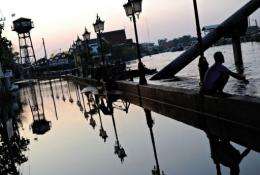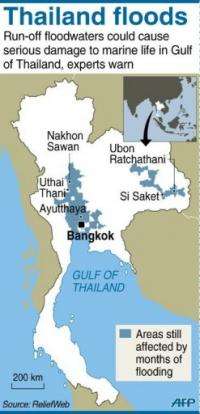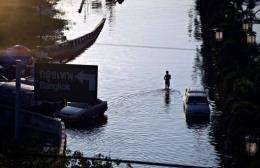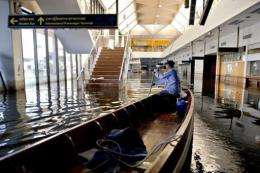Thai flood run-off threat to marine life

As billions of cubic metres of water flow away from Thailand's devastating floods, experts and campaigners are warning that millions of sea creatures could be the next victims of the disaster.
Fish and shellfish farmers on the Gulf of Thailand coast have been warned by Thai authorities to protect their stocks as an estimated 10 billion cubic metres of water flow into the gulf, massively diluting the salt water.
Environmental campaigners are also warning that pollutants in the floodwaters from agriculture and industry could have a longer-term impact -- and may even enter the food chain.
Pramot Sojisuporn, Assistant Professor at the Department of Marine Science at Bangkok's Chulalongkorn University said the huge volume of water pouring into the gulf over the next month will cause salt levels to drop significantly, affecting fish and other marine animals.

"The problem is the salinity in the upper Gulf of Thailand will be reduced as it receives the fresh water -- a lot of fresh water," he told AFP.
"The fresh water will not affect the fish (so badly) but it will affect organisms that stay in the mud, so for mussels, clams, they will die."
Pramot said the deluge of floodwaters could mean salt levels fall from the usual level of around 32 parts per thousand to around two parts per thousand, and in the inner gulf the water will be like fresh water.
"If the water is fresh for over two months they will die," he said.

Aquaculture -- farming fish, cockles, mussels, shrimps, oysters and clams -- is one of the mainstays of the economy on the gulf coast, and Pramot said the sector would be badly affected by the fall in salinity.
On Monday the Fisheries Department warned fish farmers in Samut Sakhorn province, south of Bangkok, and to the west of the capital, to harvest or move their animals and strengthen flood defences on ponds.
Ply Pirom, toxic campaigner for environmental activist group Greenpeace, said the run-off would likely kill millions of sea organisms, dealing a heavy blow to fish and shellfish farmers -- and it could affect the food chain.
"For the short term we might see some dead fish along the coast of Gulf of Thailand because of the salinity," he said.
"Some smaller organisms are more sensitive to the change of water quality and salinity, so these small organisms would die eventually and this is the food for the large fish."
Ply said that while the sea would naturally restore its salinity, there were concerns of more lasting problems from flood run-off contaminated with pollutants from agriculture and industry.

"The concern is that the run-off water picks up chemicals and goes into the Gulf of Thailand, which is a closed system," he said explaining that as a result, the pollution could enter the food chain.
"The problem is that the Gulf of Thailand is quite a closed system. There is no continuous flow. It's surrounded by land. The flow of water is very slow."
A team from Chulalongkorn University will begin testing in the gulf next week in an effort to predict how the fresh water will disperse and how far it will spread.
Pramot said the northeast monsoon would most likely spread the waters to the west of the gulf, some southern provinces and possibly the popular beach resort of Hua Hin.
The Ministry of Natural Resources and Environment will also set up around 50 points around the gulf to test water quality, and more in the estuary of the Chao Phraya, the main river that flows through Bangkok.
"We have to monitor a large volume, so we can work out how it will affect sea life, how long the effects will last and how long it will take to recover," a ministry official who asked not to be named said.
Until the research is completed it is difficult to predict how much of the gulf will be affected, or for how long, but one thing is clear -- come what may, the waters will reach the sea.
(c) 2011 AFP
















